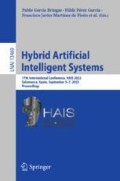Abstract
Optimisation can be described as the process of finding optimal values for the variables of a given problem in order to minimise or maximise one or more objective function(s). Brain storm optimisation (BSO) algorithm is relatively new swarm intelligence algorithm that mimics the brainstorming process in which a group of people solves a problem together. The aim of this paper is to present hybrid BSO algorithm solutions in general, and particularly: (i) a hybrid BSO for improving the performances of the original BSO algorithm; (ii) a hybrid BSO for the flexible job-shop scheduling problem; and (iii) a feature selection by a hybrid BSO algorithm for the COVID-19 classification. The hybrid BSO algorithm overcomes the lack of exploitation in the original BSO algorithm, and simultaneously, the obtained better results prove their efficiency and robustness.
Access this chapter
Tax calculation will be finalised at checkout
Purchases are for personal use only
References
Shi, Y.: An optimization algorithm based on brainstorming process. Int. J. Swarm Intell. Res. 2(4), 35–62 (2011). https://doi.org/10.4018/ijsir.2011100103
Cheng, S., Qin, Q., Chen, J., Shi, Y.: Brain storm optimization algorithm: a review. Artif. Intell. Rev. 46(4), 445–458 (2016). https://doi.org/10.1007/s10462-016-9471-0
Guo, X., Wu, Y., Xie, L., Cheng, S., Xin, J.: An adaptive brain storm optimization algorithm for multiobjective optimization problems. In: Tan, Y., Shi, Y., Buarque, F., Gelbukh, A., Das, S., Engelbrecht, A. (eds.) ICSI 2015. LNCS, vol. 9140, pp. 365–372. Springer, Cham (2015). https://doi.org/10.1007/978-3-319-94120-2_41
Shi, Y., Xue, J., Wu, Y.: Multi-objective optimization based on brain storm optimization algorithm. Int. Swarm Intell. Res. 4(3), 1–21 (2013). https://doi.org/10.4018/ijsir.2013070101
Simić, D., Ilin, V., Simić, S.D., Simić, S.: Swarm intelligence methods on inventory management. In: Graña, M., et al. (eds.) SOCO’18-CISIS’18-ICEUTE’18 2018. AISC, vol. 771, pp. 426–435. Springer, Cham (2019). https://doi.org/10.1007/978-3-319-94120-2_41
Simić, D., Ilin, V., Svirčević, V., Simić, S.: A hybrid clustering and ranking method for best positioned logistics distribution centre in Balkan Peninsula. Logic J. IGPL 25(6), 991–1005 (2017). https://doi.org/10.1093/jigpal/jzx047
Simić, D., Svirčević, V., Ilin, V., Simić, S.D., Simić, S.: Particle swarm optimization and pure adaptive search in finish goods’ inventory management. Cybern. Syst. 50(1), 58–77 (2019). https://doi.org/10.1080/01969722.2018.1558014
Simić, D., Svirčević, V., Corchado, E., Calvo-Rolle, J.L., Simić, S.D., Simić, S.: Modelling material flow using the Milk run and Kanban systems in the automotive industry. Expert. Syst. 38(1), e12546 (2021). https://doi.org/10.1111/exsy.12546
Zayas-Gato, F., et al.: A hybrid one - class approach for detecting anomalies in industrial systems. Expert Syst. e12990 (2022). https://doi.org/10.1111/exsy.12990
Goldberg, D.E., Deb, K.: A comparative analysis of selection schemes used in genetic algorithms. Found. Genet. Algorithms 1, 69–93 (1991). https://doi.org/10.1016/B978-0-08-050684-5.50008-2
Cheng, S., Shi, Y., Qin, Q., Ting, T.O., Bai, R.: Maintaining population diversity in brain storm optimization algorithm. In: Proceedings of 2014 IEEE Congress on Evolutionary Computation (CEC 2014), pp. 3230–3237. IEEE, Beijing (2014)
Cao, Z., Rong, X., Du, Z.: An improved brain storm optimization with dynamic clustering strategy. MATEC Web Conf. 95, 19002 (2017). https://doi.org/10.1051/matecconf/20179519002
Liu, J., Peng, H., Wu, Z., Chen, J., Deng, C.: Multi-strategy brain storm optimization algorithm with dynamic parameters adjustment. Appl. Intell. 50(4), 1289–1315 (2020). https://doi.org/10.1007/s10489-019-01600-7
Alzaqebah, M., Jawarneh, S., Alwohaibi, M., Alsmadi, M.K., Almarashdeh, I., Mohammad, R.M.A.: Hybrid brain storm optimization algorithm and late acceptance hill climbing to solve the flexible job-shop scheduling problem. J. King Saud Univ. – Comput. Inf. Sci. (2020). https://doi.org/10.1016/j.jksuci.2020.09.004
Garey, M.R., Johnson, D.S., Sethi, R.: The complexity of flowshop and jobshop scheduling. Math. Oper. Res. 1(2), 117–129 (1976)
Genova, K., Kirilov, L., Guliashki, V.: A survey of solving approaches for multiple objective flexible job shop scheduling problems. Cybern. Inf. Technol. 15(2), 3–22 (2015). https://doi.org/10.1515/cait-2015-0025
Bholowalia, P., Kumar, A.: EBK-means: a clustering technique based on elbow method and k-means in WSN. Int. J. Comput. Appl. 105(9) (2014). https://doi.org/10.5120/18405-9674
Bezdan, T., Živković, M., Bacanin, N., Chhabra, A., Suresh, M.: Feature selection by hybrid brain storm optimization algorithm for COVID-19 classification. J. Comput. Biol. 29(6), 1–15 (2022). https://doi.org/10.1089/cmb.2021.0256
Yang, X.-S.: Firefly algorithms for multimodal optimization. In: Watanabe, O., Zeugmann, T. (eds.) SAGA 2009. LNCS, vol. 5792, pp. 169–178. Springer, Heidelberg (2009). https://doi.org/10.1007/978-3-642-04944-6_14
Dua, D., Graff, C: UCI Machine Learning Repository. http://archive.ics.uci.edu/ml. Accessed 28 Sept 2020
https://github.com/Atharva-Peshkar/Covid-19-Patient-Health-Analytics. Accessed 25 Sept 2020
Iwendi, C., et al.: COVID-19 patient health prediction using boosted random forest algorithm. Front. Public Health 8, 357 (2020). https://doi.org/10.3389/fpubh.2020.00357
Mohamed, A.W., Hadi, A.A., Mohamed, A.K.: Gaining-sharing knowledge based algorithm for solving optimization problems: a novel nature-inspired algorithm. Int. J. Mach. Learn. Cybern. 11(5), 1501–1529 (2020). https://doi.org/10.1007/s13042-019-01053-x
Agrawal, P., Ganesh, T., Mohamed, A.W.: Chaotic gaining sharing knowledge-based optimization algorithm: an improved metaheuristic algorithm for feature selection. Soft. Comput. 25(14), 9505–9528 (2021). https://doi.org/10.1007/s00500-021-05874-3
Agrawal, P., Ganesh, T., Mohamed, A.W.: A novel binary gaining-sharing knowledge-based optimization algorithm for feature selection. Neural Comput. Appl. 33(11), 5989–6008 (2021). https://doi.org/10.1007/s00521-020-05375-8
Agrawal, P., Ganesh, T., Oliva, D., Mohamed, A.W.: S-shaped and v-shaped gaining-sharing knowledge-based algorithm for feature selection. Appl. Intell. 52(1), 81–112 (2022). https://doi.org/10.1007/s10489-021-02233-5
Too, J., Mirjalili, S.: A hyper learning binary dragonfly algorithm for feature selection: a COVID-19 case study. Knowl. Based Syst. 212, 106553 (2021). https://doi.org/10.1016/j.knosys.2020.106553
Khalilpourazari, S., Doulabi, H.H., Çiftçioğluc, A.O., Weber, G.-W.: Gradient-based grey wolf optimizer with Gaussian walk: application in modelling and prediction of the COVID-19 pandemic. Expert Syst. Appl. 177, 114920 (2021)
Canayaz, M., Şehribanoğlu, S., Özdağ, R., Demir, M.: COVID-19 diagnosis on CT images with Bayes optimization-based deep neural networks and machine learning algorithms. Neural Comput. Appl. 34(7) (2022). https://doi.org/10.1007/s00521-022-07052-4
Alali, Y., Harrou, F., Sun, Y.: A proficient approach to forecast COVID-19 spread via optimized dynamic machine learning models. Sci. Rep. 12(1), 2467 (2022). https://doi.org/10.1038/s41598-022-06218-3
Author information
Authors and Affiliations
Corresponding author
Editor information
Editors and Affiliations
Rights and permissions
Copyright information
© 2022 Springer Nature Switzerland AG
About this paper
Cite this paper
Simić, D., Banković, Z., Villar, J.R., Calvo-Rolle, J.L., Simić, S.D., Simić, S. (2022). An Analysis on Hybrid Brain Storm Optimisation Algorithms. In: García Bringas, P., et al. Hybrid Artificial Intelligent Systems. HAIS 2022. Lecture Notes in Computer Science(), vol 13469. Springer, Cham. https://doi.org/10.1007/978-3-031-15471-3_43
Download citation
DOI: https://doi.org/10.1007/978-3-031-15471-3_43
Published:
Publisher Name: Springer, Cham
Print ISBN: 978-3-031-15470-6
Online ISBN: 978-3-031-15471-3
eBook Packages: Computer ScienceComputer Science (R0)

